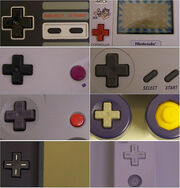No edit summary |
m (Added NSL) Tag: Visual edit |
||
| (7 intermediate revisions by 7 users not shown) | |||
| Line 1: | Line 1: | ||
| + | {{Head |
||
| ⚫ | |||
| + | | type = Accessory |
||
| ⚫ | The '''D-pad''', also known as the '''Directional Pad''', is |
||
| + | | quote = |
||
| + | | speaker = |
||
| + | | stub = |
||
| ⚫ | |||
| ⚫ | The '''D-pad''', also known as the '''Directional Pad''', is a form of directional control first implemented on the [[Game and Watch]] unit [[Donkey Kong (Game & Watch)|Donkey Kong]], and featured prominently on the [[Famicom]] ([[NES]]). It includes four different directions including up, down, left and right. The direction you press will cause the object on screen to move in that direction in most cases. For example, in ''[[Super Mario Bros.]]'' for the NES, if the player presses right on the D-pad, then either [[Mario]] or [[Luigi]] (depending on the character) will move in that direction. |
||
| − | Most recently the d-pad, while still found on most controllers, has been replaced by the modern |
+ | Most recently the d-pad, while still found on most controllers, has been replaced by the modern day [[Joystick]], which was first featured on the [[Nintendo 64]]. |
Unlike most controllers, the [[Virtual Boy]] had two D-Pads. One for moving around with and to look around. |
Unlike most controllers, the [[Virtual Boy]] had two D-Pads. One for moving around with and to look around. |
||
| − | ==[[Nintendo]] |
+ | ==[[Nintendo]] systems with a d-pad== |
| − | *[[ |
+ | *[[Nintendo Entertainment System controller|Nintendo Entertainment System]] |
| + | *[[Super Nintendo Entertainment System controller|Super Nintendo Entertainment System]] |
||
| + | *[[Nintendo 64 controller|Nintendo 64]] |
||
| + | *[[Virtual Boy]] |
||
| + | *[[GameCube]] ([[GameCube Controller |GameCube Controller]]) |
||
| + | *[[Wii]] ([[Wii Remote]] and [[Classic Controller]]) |
||
| + | *[[Game & Watch]] - 11 Units (see [[List of Game and Watch units featuring D-pads]]) |
||
| + | *[[Game Boy]] (every type) |
||
| + | *[[Nintendo DS]] ([[DS Lite]], [[Nintendo DSi]], [[Nintendo DSi XL]]) |
||
| + | *[[Nintendo 3DS]] (All iterations) |
||
| + | *[[Wii U]] ([[Wii U GamePad]] and [[Wii U Pro Controller]]) |
||
| + | *[[Nintendo Switch Pro Controller]] |
||
| + | *[[Nintendo Switch Lite]] |
||
[[Category: Controllers]] |
[[Category: Controllers]] |
||
Latest revision as of 20:49, 12 July 2019
|

Various different Nintendo d-pads. Clockwise from top left: NES, Game & Watch, SNES, GameCube, Wii, DS Lite, Nintendo 64, Game Boy.
The D-pad, also known as the Directional Pad, is a form of directional control first implemented on the Game and Watch unit Donkey Kong, and featured prominently on the Famicom (NES). It includes four different directions including up, down, left and right. The direction you press will cause the object on screen to move in that direction in most cases. For example, in Super Mario Bros. for the NES, if the player presses right on the D-pad, then either Mario or Luigi (depending on the character) will move in that direction.
Most recently the d-pad, while still found on most controllers, has been replaced by the modern day Joystick, which was first featured on the Nintendo 64.
Unlike most controllers, the Virtual Boy had two D-Pads. One for moving around with and to look around.
Nintendo systems with a d-pad
- Nintendo Entertainment System
- Super Nintendo Entertainment System
- Nintendo 64
- Virtual Boy
- GameCube (GameCube Controller)
- Wii (Wii Remote and Classic Controller)
- Game & Watch - 11 Units (see List of Game and Watch units featuring D-pads)
- Game Boy (every type)
- Nintendo DS (DS Lite, Nintendo DSi, Nintendo DSi XL)
- Nintendo 3DS (All iterations)
- Wii U (Wii U GamePad and Wii U Pro Controller)
- Nintendo Switch Pro Controller
- Nintendo Switch Lite
